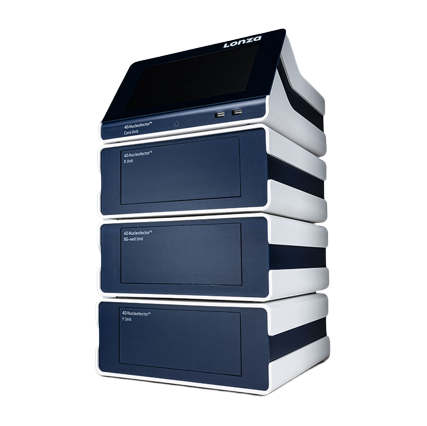



Lonza 4D-Nucleofector® System
Ensure you obtain the very highest levels of transfection efficiency and quality for your research
The Nucleofector® Technology uses a specific combination of optimized electrical parameters and cell type-specific solutions which enables transfer of a molecule directly into the cells’ nucleus. Due to this independency from cell proliferation, it allows for efficient transfection of even non-dividing primary cells (like resting T cells or neurons) and also speeds up expression.
Since launching the Nucleofector® Technology by legacy Amaxa, we have introduced several innovations around those three components to expand its application to further cell types, lower and higher cell numbers or different throughputs.
The Nucleofector® Technology offers a higher transfection efficiency than other non-viral transfection methods (including traditional electroporation1) along with other significant advantages outlined below.
With its superior transfection performance, Nucleofection offers various advantages over traditional electroporation methods:
Additionally, using Nucleofector® Technology can bring various practical benefits to your research, including:
These benefits can facilitate numerous applications, such as therapeutic gene knock-down via RNAi2 or CRISPR3 and the generation of induced pluripotent stem cells4 or CAR-T5, among many others. It is therefore not surprising that Nucleofector® Technology is now used in many different lines of research, including functional and structural genomics, drug discovery, and gene and cell therapy.
1 Maasho et al 2004 Journal of Immunological Methods
2 Marques and Williams, 2005 Nature Biotechnology
3 Seki A, Rutz S, 2018 J Exp Med
We have developed three different Nucleofector® Platforms that offer a range of different specifications and units to enable flexible scaling (i.e., Nucleofection of varying numbers and volume of cells depending on the application) as well as transfection of adherent cells.
This advanced, flexible and convenient 4D-Nucleofector® System comprises a core unit, as well as the following functional units and add-on devices with different transfection capabilities to suit different applications.
The 4D-Nucleofector® X Unit features positions for both 20 µL Nucleocuvette® Strips and 100 µL single Nucleocuvette® Vessels. Conditions can be seamlessly transferred between these two vessel types. Furthermore, cells that have been transfected using the X Unit, can be transferred to other Nucleofector Platforms (96-well Shuttle® Device, HT Nucleofector® System, and 4D-Nucleofector® LV Unit) without the need for re-optimization. Learn more by visiting our 4D-Nucleofector® X Unit product page or by watching the video.
Electroporation usually requires cells to be in suspension for transfection. However, the 4D-Nucleofector® Y Unit offers the opportunity to keep cells in adherence during electroporation. Adherent primary cells, especially neurons, at defined developmental stages can be transfected using the Y Unit without affecting their functionality and with an efficiency of up to 70%. To find out more, watch the video or read more information on the 4D-Nucleofector® Y Unit product page.
The 4D-Nucleofector 96-well® Unit offers a medium-throughput add-on for the 4D-Nucleofector® System. It is suited for the convenient optimization of Nucleofection® Conditions or as an assay establishment tool. The 4D-Nucleofector® 96-well Unit serves as a plate handler that mediates the transfer of the a Nucleofector® Program generated by the 4D-Nucleofector® Core and X Unit to a specific well of the 96-well Nucleocuvette® Plate. For scalable throughput, each well of the plate can be addressed and transfected individually. This is useful for optimizing difficult-to-transfect cell lines in just one plate, as well as transfecting variable cell numbers from 104 – 106 cells per reaction. Learn more by visiting the 4D-Nucleofector® 96-well Unit page here and watching the video tutorial.
The 4D-Nucleofector® LV Unit enables closed, scalable and sterile transfection of larger cell numbers in the range of 1x107 to 1x109 cells. It offers two large-scale transfection formats, 1 mL Nucleocuvette® Cartridges or LV Nucleocuvette® Cartridges for a processing volume of up to 20 mL, depending on the application and how many cells need to be transfected. The large-scale transfection capabilities of the LV Unit have made it suitable for a wide range of applications. GMP grade TheraPEAK® Consumables, and a 21CFR part 11 compliant software and IQOQ services allows you to quickly translate research results into a GMP compliant cell therapy manufacturing process. You can read our 4D-Nucleofector® LV Unit product page for more information.
For details of 4D-Nucleofector® System, please find the information in the Transfection area from Equipment of our products or directly email us at cs@medikonia.com.